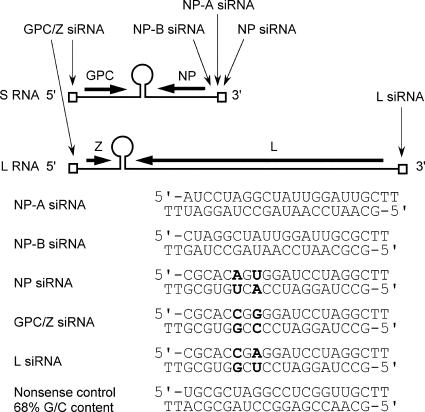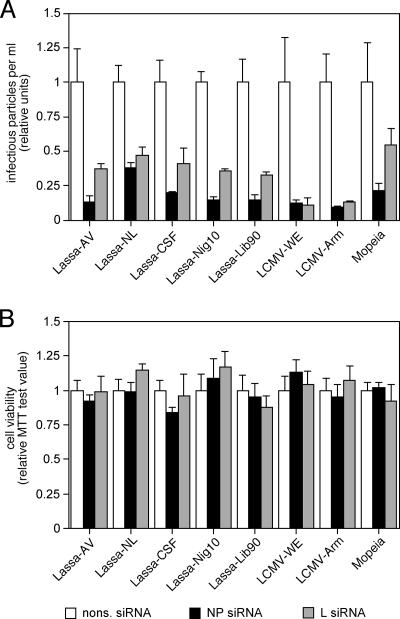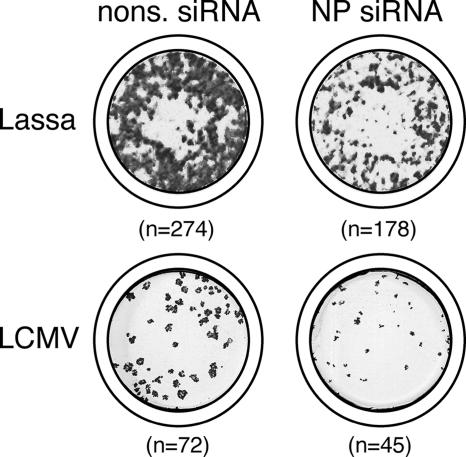Abstract
Small interfering RNAs targeting the conserved RNA termini upstream of NP and L gene were found to reduce reporter gene expression from Lassa virus replicon and Lassa virus mRNA expression construct and to inhibit replication of different Lassa virus strains, lymphocytic choriomeningitis virus, and Mopeia virus in cell culture.
Lassa virus is classified as a level 4 pathogen because options for preventing and treating Lassa fever are limited. Recently, it has been demonstrated that arenaviruses are amenable to RNA interference by using small interfering RNA (siRNA) specific for the Armstrong strain of lymphocytic choriomeningitis virus (LCMV) (16). We investigated whether siRNA has potential for therapeutic use against Lassa virus infection by targeting highly conserved sites. A major obstacle to the application of siRNA against variable viruses is that, for activity, siRNA must perfectly base pair to the target sequence. The 19-nucleotide-long termini of the arenavirus RNA segments are completely conserved among the virus family (Table 1) (1). They form the promoter for replication and transcription (10, 13) and are transcribed to viral mRNA.
TABLE 1.
Conserved RNA termini of arenaviruses
| Gene | Sequence of RNA terminusa | Viruses sequenced (GenBank accession no.)b |
|---|---|---|
| GPC | CGCACCGGGGATCCTAGGC | Lassa virus Josiah (M15076), Lassa virus AV (AF246121), LCMV Armstrong (M20869), LCMV WE (M22138), Pichinde virus (K02734), Oliveros virus (U34248), Sabia virus (U41071), Allpahuayo virus (AY012686) |
| NP | CGCACAGTGGATCCTAGGC | Lassa virus Josiah (J04324), Lassa virus AV (AF246121), Lassa virus GA391 (K03362), LCMV Armstrong (J02242, M20869), LCMV WE (M22138), Pichinde virus (J02279, K02734), Oliveros virus (U34248), Tacaribe virus (J02411) |
| Z | CGCACCGGGGATCCTAGGC | Lassa virus Josiah (U73034), LCMV Armstrong (M27693), LCMV WE (AF004519), Tacaribe virus (J04340) |
| L | CGCACCGAGGATCCTAGGC | Lassa virus Josiah (U73034), LCMV Armstrong (J04331), LCMV WE (AF004519), Pichinde virus (J02277) |
Sequences are written in 5′-3′ orientation in mRNA sense. Positions with natural variability between the four termini are underlined.
The table lists all viruses for which there is published evidence that the authentic termini have been sequenced (for the references see the GenBank entries). Additional terminal sequences, which do not represent authentic virus sequences, are also deposited in GenBank. They are derived from primers used for reverse transcription or PCR amplification of the arenavirus genome and were mistakenly not removed from the sequence entry. Some of the primer-derived sequences do not match the authentic sequence due to the use of consensus primers.
Three siRNAs matching the three variants of terminal sequences (NP, GPC/Z, and L siRNA) and two siRNAs targeting sites conserved only among Lassa virus (NP-A and NP-B siRNA) were synthesized and purified by high-pressure liquid chromatography (MWG Biotech, Ebersberg, Germany) (Fig. 1). They were initially tested by using the Lassa virus replicon system (9). The functional cassette of minigenome plasmid pLAS-MG (T7 promoter, 5′ untranslated region [UTR]; intergenic region [IGR]; Renilla luciferase [Ren-Luc] gene in reverse orientation; and 3′UTR) was amplified, and the PCR products were directly used for transfection (9, 10). To facilitate testing of NP, GPC/Z, and L siRNA, minigenomes with 3′ ends corresponding to the conserved termini upstream of NP, GPC/Z, or L gene (MG-NP, MG-GPC/Z, and MG-L, respectively) were generated by using Phusion High-Fidelity DNA polymerase (Finnzymes, Espoo, Finland), 3 ng of pLAS-MG, primer pUC-fwd, and primer LVS-3400-NP− (CGCACAGTGGATCCTAGGCTATTGGA) for MG-NP, LVS-3400-GPC/Z− (CGCACCGGGGATCCTAGGCTATTGGA) for MG-GPC/Z, or LVS-3400-L− (CGCACCGAGGATCCTAGGCTATTGGA) for MG-L. Minigenomes were purified and quantified spectrophotometrically. BSR-T7/5 cells (a rodent cell line stably expressing T7 RNA polymerase [3]) in a well of a 24-well plate were transfected with 250 ng of MG-NP, MG-GPC/Z, or MG-L, 250 ng of pCITE-NP, 250 ng of pCITE-L (NP, and L protein expression plasmids, respectively [9]), 10 ng of pCITE-FF-luc (firefly luciferase expression plasmid [9]) as a transfection control, and 10 or 50 pmol of siRNA using Lipofectamine 2000 (Invitrogen, Karlsruhe, Germany). Nonsense siRNA with 68% G+C content (MWG Biotech) served as a negative control. Medium was replaced 4 h posttransfection. One day after transfection, firefly luciferase and Ren-Luc activity were measured using the Dual-Luciferase Reporter Assay System (Promega, Mannheim, Germany). Ren-Luc levels were corrected with the firefly luciferase levels. NP siRNA inhibited replicon activity by 75%, while NP-A, NP-B, and L siRNAs showed ca. 50% inhibition. GPC/Z siRNA was hardly effective (Fig. 2). To demonstrate the specificity of the siRNA effect, NP, GPC/Z, and L siRNA were tested against all minigenome variants (Fig. 3A). NP and L siRNA preferentially inhibited MG-NP and MG-L, respectively, containing the homologous target site (Fig. 3B).
FIG. 1.
Target site and sequence of siRNA duplexes used in the study. A schematic representation of the arenavirus RNA segments is shown at the top. Genes are indicated by long horizontal arrows, and the conserved termini are indicated by open boxes. Positions that differ between NP, GPC/Z, and L siRNA are shown in boldface.
FIG. 2.
Testing of siRNA using the Lassa virus replicon system. BSR-T7/5 cells were transfected with components of the Lassa virus minireplicon system (Ren-Luc), a control plasmid expressing firefly luciferase, and 10 pmol of Lassa virus-specific or nonsense (nons.) control siRNA. Minigenomes with three different termini upstream of the reporter gene were used for testing: with NP gene-specific terminus for testing NP, NP-A, NP-B, and nonsense 1 siRNA; with GPC/Z gene-specific terminus for testing GPC/Z and nonsense 2 siRNA; and with L gene-specific terminus for testing L and nonsense 3 siRNA. Renilla and firefly luciferase activity were measured 24 h posttransfection. Replicon activity is expressed as the Renilla/firefly luciferase ratio. Replicon activity in the presence of nonsense siRNA was set at 1. Mean and range of duplicate transfections are shown.
FIG. 3.
Specificity of siRNA activity as tested with replicon system and CMV promoter-driven constructs. (A) Schematic representation of replicon and CMV constructs with NP, GPC/Z, or L gene-specific termini upstream of the reporter gene. The nucleotide differences between the three variants are boxed. Renilla luc, Renilla luciferase gene; T7-p, T7 RNA polymerase promoter; CMV-p, human cytomegalovirus IE1 gene promoter; SV40 poly-A, simian virus 40 polyadenylation signal. (B) The NP, GPC/Z, or L terminus-specific replicon was cotransfected with 50 pmol of NP, GPC/Z, or L siRNA or nonsense (nons.) siRNA. Replicon activity is expressed as the Renilla/firefly luciferase ratio. Means and standard deviations (n = 4) of values obtained in two independent transfection experiments are shown. (C) NP, GPC/Z, or L terminus-specific CMV construct was cotransfected with 50 pmol NP, GPC/Z, or L siRNA or nonsense (nons.) siRNA. The expression level is expressed as the Renilla/firefly luciferase ratio. The experiment was performed twice. The means and ranges (n = 2) of one representative experiment are shown.
Since the NP, GPC/Z, and L siRNA duplexes are basically identical to the natural Lassa virus promoter (10, 13), they might interfere with promoter-polymerase interaction. To exclude this possibility, the siRNAs were also tested in a heterologous expression system. Expression constructs for Lassa virus mRNA analogs (pCMV-NP, pCMV-GPC/Z, and pCMV-L) contained the human cytomegalovirus (CMV) IE1 promoter upstream of the conserved terminus of NP, GPC/Z, or L gene; the UTR; the Ren-Luc gene; the IGR; and the polyadenylation site (Fig. 3A). HuH-7 cells in a well of a 24-well plate were transfected with 300 ng of pCMV-NP, pCMV-GPC/Z, or pCMV-L; 30 ng of pRK5-FF-luc (CMV promoter construct expressing firefly luciferase); and 25 pmol siRNA using X-tremeGENE siRNA Transfection Reagent (Roche, Mannheim, Germany). Medium was replaced 4 h after transfection, and luciferase activity was measured 24 h posttransfection. Each siRNA was tested against all constructs. NP and L siRNA specifically reduced reporter gene expression from the construct with the homologous target sites (Fig. 3C). Taken together, data from replicon and CMV promoter system indicate that the siRNA effect is target site-specific and not caused by interference with promoter binding.
The two effective siRNAs (NP and L) were further evaluated in cell culture using five Lassa virus isolates of different genetic lineages (NL, Sierra Leone [17]; LIB-90, Liberia; AV, Ivory Coast [6]; NIG-10, Nigeria [11]; and CSF, Nigeria [7]), LCMV (WE and Armstrong), and Mopeia virus (AN21366). Vero cells in a well of a 24-well plate were transfected with 50 pmol of siRNA using X-tremeGENE and infected 4 h later at a multiplicity of infection of 0.01. The virus titer in cell culture supernatant was determined after 48 h by immunological focus assay (8). Both siRNAs inhibited replication of all virus strains tested by up to 1 log unit (Fig. 4A). They had no effect on cell viability as tested by methylthiazolyldiphenyl-tetrazolium bromide (MTT) assay (8) (Fig. 4B).
FIG. 4.
Effect of NP and L siRNA on replication of different Lassa virus strains, LCMV, and Mopeia virus. Vero cells were transfected with 50 pmol of siRNA and infected with virus at a multiplicity of infection of 0.01. Virus titer in cell culture supernatant and cell viability were measured 2 days postinfection. Means and standard deviations of triplicate experiments are shown. (A) Virus titer in supernatant as measured by an immunological focus assay. The titer in the presence of nonsense control siRNA was set at 1. The absolute virus titers of the controls were (in PFU/ml) as follows: Lassa virus AV, 9.4 × 105; NL, 4.1 × 106; CSF, 1.3 × 105; NIG-10, 7.5 × 105; LIB-90, 7.4 × 105; LCMV WE, 1.2 × 105; Armstrong, 3.9 × 105; and Mopeia virus, 1.6 × 106. (B) Cell viability as measured with an MTT test. After completion of the virus growth assay, the cells were used for the MTT test.
NP siRNA was also tested in an infectious focus reduction assay. Vero cells were transfected with 50 pmol siRNA, infected with Lassa virus or LCMV, and overlaid with methylcellulose. Infected foci were visualized after 5 days by immunological focus assay. NP siRNA reduced the numbers and sizes of foci (Fig. 5).
FIG. 5.
Effect of NP siRNA on Lassa virus and LCMV replication as tested in infectious focus reduction assay. Vero cells were transfected with 50 pmol of NP siRNA and infected with 100 to 200 PFU Lassa virus AV or LCMV WE. Nonsense (nons.) siRNA was used as a control. Cells were overlaid with methylcellulose, and the number of infectious foci was visualized after 5 days by immunological staining. The numbers in parentheses are the numbers of foci.
This study demonstrates antiviral activity of NP and L siRNA against various Old World arenaviruses. Although NP, GPC/Z, and L siRNA differ only marginally, there was a clear order in their inhibitory activity: NP > L > GPC/Z. It seems the activity of the siRNA is inversely correlated with its G+C content (NP, 63%; L, 68%; GPC/Z, 73%). This is consistent with studies showing that a high G+C content hampers siRNA functionality (15). Although NP and L siRNA showed only moderate effects in replicon and CMV promoter system, they reduced the infectious virus titer by up to 90%. This suggests that even partial reduction of essential gene products can considerably affect a highly replicative virus system. Similar observations have been made with siRNAs targeting essential genes of herpes simplex virus type 2 (12). The effect of NP siRNA did not reach the 4-log inhibition obtained with recombinant adenovirus-supplied siRNA against LCMV (16). However, it was similarly active to other transiently transfected siRNAs directed against JC virus (14), herpes simplex virus type 2 (12), West Nile virus (2), Ebola virus (5), rotavirus (4), and coxsackievirus B3 (18, 19). Some of these siRNAs show potent antiviral activity in animal models (2, 5, 12). Whether NP and L siRNAs are active in vivo remains to be investigated.
Acknowledgments
This study was part of the contract research project M/SAB1/5/A008 for the Bundeswehr Medical Service. The Bernhard-Nocht-Institute is supported by the Bundesministerium für Gesundheit and the Freie und Hansestadt Hamburg.
We thank Nadja Höfs for technical assistance.
Footnotes
Published ahead of print on 19 March 2007.
REFERENCES
- 1.Auperin, D. D., R. W. Compans, and D. H. Bishop. 1982. Nucleotide sequence conservation at the 3′ termini of the virion RNA species of New World and Old World arenaviruses. Virology 121:200-203. [DOI] [PubMed] [Google Scholar]
- 2.Bai, F., T. Wang, U. Pal, F. Bao, L. H. Gould, and E. Fikrig. 2005. Use of RNA interference to prevent lethal murine West Nile virus infection. J. Infect. Dis. 191:1148-1154. [DOI] [PubMed] [Google Scholar]
- 3.Buchholz, U. J., S. Finke, and K. K. Conzelmann. 1999. Generation of bovine respiratory syncytial virus (BRSV) from cDNA: BRSV NS2 is not essential for virus replication in tissue culture, and the human RSV leader region acts as a functional BRSV genome promoter. J. Virol. 73:251-259. [DOI] [PMC free article] [PubMed] [Google Scholar]
- 4.Dector, M. A., P. Romero, S. Lopez, and C. F. Arias. 2002. Rotavirus gene silencing by small interfering RNAs. EMBO Rep. 3:1175-1180. [DOI] [PMC free article] [PubMed] [Google Scholar]
- 5.Geisbert, T. W., L. E. Hensley, E. Kagan, E. Z. Yu, J. B. Geisbert, K. Daddario-DiCaprio, E. A. Fritz, P. B. Jahrling, K. McClintock, J. R. Phelps, A. C. Lee, A. Judge, L. B. Jeffs, and I. MacLachlan. 2006. Postexposure protection of guinea pigs against a lethal ebola virus challenge is conferred by RNA interference. J. Infect. Dis. 193:1650-1657. [DOI] [PMC free article] [PubMed] [Google Scholar]
- 6.Günther, S., P. Emmerich, T. Laue, O. Kühle, M. Asper, A. Jung, T. Grewing, J. ter Meulen, and H. Schmitz. 2000. Imported lassa fever in Germany: molecular characterization of a new Lassa virus strain. Emerg. Infect. Dis. 6:466-476. [DOI] [PMC free article] [PubMed] [Google Scholar]
- 7.Günther, S., B. Weisner, A. Roth, T. Grewing, M. Asper, C. Drosten, P. Emmerich, J. Petersen, M. Wilczek, and H. Schmitz. 2001. Lassa fever encephalopathy: Lassa virus in cerebrospinal fluid but not in serum. J. Infect. Dis. 184:345-349. [DOI] [PubMed] [Google Scholar]
- 8.Günther, S., M. Asper, C. Röser, L. K. Luna, C. Drosten, B. Becker-Ziaja, P. Borowski, H. M. Chen, and R. S. Hosmane. 2004. Application of real-time PCR for testing antiviral compounds against Lassa virus, SARS coronavirus and Ebola virus in vitro. Antivir. Res. 63:209-215. [DOI] [PMC free article] [PubMed] [Google Scholar]
- 9.Hass, M., U. Gölnitz, S. Müller, B. Becker-Ziaja, and S. Günther. 2004. Replicon system for Lassa virus. J. Virol. 78:13793-13803. [DOI] [PMC free article] [PubMed] [Google Scholar]
- 10.Hass, M., M. Westerkofsky, S. Müller, B. Becker-Ziaja, C. Busch, and S. Günther. 2006. Mutational analysis of the Lassa virus promoter. J. Virol. 80:12414-12419. [DOI] [PMC free article] [PubMed] [Google Scholar]
- 11.Omilabu, S. A., S. O. Badaru, P. Okokhere, D. Asogun, C. Drosten, P. Emmerich, B. Becker-Ziaja, H. Schmitz, and S. Günther. 2005. Lassa fever, Nigeria, 2003 and 2004. Emerg. Infect. Dis. 11:1642-1644. [DOI] [PMC free article] [PubMed] [Google Scholar]
- 12.Palliser, D., D. Chowdhury, Q. Y. Wang, S. J. Lee, R. T. Bronson, D. M. Knipe, and J. Lieberman. 2006. An siRNA-based microbicide protects mice from lethal herpes simplex virus 2 infection. Nature 439:89-94. [DOI] [PubMed] [Google Scholar]
- 13.Perez, M., and J. C. de la Torre. 2003. Characterization of the genomic promoter of the prototypic arenavirus lymphocytic choriomeningitis virus. J. Virol. 77:1184-1194. [DOI] [PMC free article] [PubMed] [Google Scholar]
- 14.Radhakrishnan, S., J. Gordon, L. Del Valle, J. Cui, and K. Khalili. 2004. Intracellular approach for blocking JC virus gene expression by using RNA interference during viral infection. J. Virol. 78:7264-7269. [DOI] [PMC free article] [PubMed] [Google Scholar]
- 15.Reynolds, A., D. Leake, Q. Boese, S. Scaringe, W. S. Marshall, and A. Khvorova. 2004. Rational siRNA design for RNA interference. Nat. Biotechnol. 22:326-330. [DOI] [PubMed] [Google Scholar]
- 16.Sanchez, A. B., M. Perez, T. Cornu, and J. C. de la Torre. 2005. RNA interference-mediated virus clearance from cells both acutely and chronically infected with the prototypic arenavirus lymphocytic choriomeningitis virus. J. Virol. 79:11071-11081. [DOI] [PMC free article] [PubMed] [Google Scholar]
- 17.Schmitz, H., B. Köhler, T. Laue, C. Drosten, P. J. Veldkamp, S. Günther, P. Emmerich, H. P. Geisen, K. Fleischer, M. F. Beersma, and A. Hoerauf. 2002. Monitoring of clinical and laboratory data in two cases of imported Lassa fever. Microbes Infect. 4:43-50. [DOI] [PubMed] [Google Scholar]
- 18.Werk, D., S. Schubert, V. Lindig, H. P. Grunert, H. Zeichhardt, V. A. Erdmann, and J. Kurreck. 2005. Developing an effective RNA interference strategy against a plus-strand RNA virus: silencing of coxsackievirus B3 and its cognate coxsackievirus-adenovirus receptor. Biol. Chem. 386:857-863. [DOI] [PubMed] [Google Scholar]
- 19.Yuan, J., P. K. Cheung, H. M. Zhang, D. Chau, and D. Yang. 2005. Inhibition of coxsackievirus B3 replication by small interfering RNAs requires perfect sequence match in the central region of the viral positive strand. J. Virol. 79:2151-2159. [DOI] [PMC free article] [PubMed] [Google Scholar]







